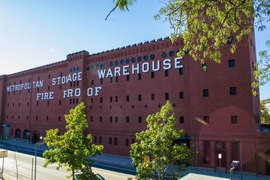MIT has been exploring options for the creative reuse of the iconic Metropolitan Storage Warehouse, located at the corner of Massachusetts Avenue and Vassar Street. The Institute, with guidance from the MIT students, faculty, and staff who have been working as part of the Metropolitan Warehouse Advisory Group, is continuing to imagine a renovation of the warehouse focusing on reuses of the building as maker spaces, common and study spaces, research and innovation spaces, and street-level retail.
The oldest parts of the Metropolitan Storage Warehouse date to 1894; the newest are from 1911. The facility, which MIT has owned since 1966, is listed on the National Register of Historic Places. While the building’s beautiful and complex structure present enticing opportunities for creative reuse, these same features also present unique architectural and design challenges.
“While we had hoped that the Met Warehouse might be repurposed as fun and functional student housing, the building’s age and style makes this a vexing undertaking for a September 2018 opening, even for our solutions-oriented community,” says Associate Provost Karen Gleason, the Alexander and I. Michael Kasser Professor in the Department of Chemical Engineering, and chair of the Metropolitan Warehouse Advisory Group.
MIT had been working toward a goal of September 2018 for the opening of the new facility; that goal had reflected the Institute’s need for more student housing, and for flexibility during renovations of existing undergraduate and graduate housing. That timeline will now be pushed back: The ambitious, multistep process of completing final design, obtaining City of Cambridge permits, and reconstructing a 100-plus-year-old building make a September 2018 reopening an unlikely outcome.
MIT’s focus for new student housing opportunities will now shift to exploring alternative sites for a residence hall, likely in the West Campus area. Over the past year, a holistic study of the West Campus was initiated and will provide a basis for determining options for student housing in the coming months. Administrators plan to develop a quick study of other student housing possibilities.
“The Met Warehouse looms large at MIT,” Gleason says. “But as a storage facility, it has not been integral to the life and work of our community. As we proceed with our plans for the creative reuse of the Met Warehouse, we are as confident as ever that our work will make this building far more of a distinctive asset to our community than it has ever been before.”










